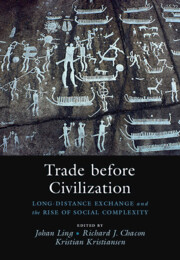Book contents
- Trade before Civilization
- Trade before Civilization
- Copyright page
- Contents
- Contributors
- Chapter One New Perspectives on Long-Distance Trade and Social Complexity
- Part I Exchange and Social Evolution: Forms of Trade in Egalitarian, Transegalitarian, and Chiefdom Societies
- Part II The Role That Specific Institutions And Agents Played in Long-Distance Exchange
- Part III The Role of Political Economy and Elite Control in Long-Distance Exchange
- Chapter Nine Lapita Long-Distance Interactions in the Western Pacific
- Chapter Ten Trade and the Hillfort Chiefdoms of Bronze Age Ireland
- Chapter Eleven The Turquoise Corridor
- Part IV Marxian And Post-Colonial Approaches as well as World System Theory in Relation to Gift Exchange and MacroRegional Exchange
- Part V Commentary on Contributions to This Volume
- Index
- References
Chapter Ten - Trade and the Hillfort Chiefdoms of Bronze Age Ireland
from Part III - The Role of Political Economy and Elite Control in Long-Distance Exchange
Published online by Cambridge University Press: 25 August 2022
- Trade before Civilization
- Trade before Civilization
- Copyright page
- Contents
- Contributors
- Chapter One New Perspectives on Long-Distance Trade and Social Complexity
- Part I Exchange and Social Evolution: Forms of Trade in Egalitarian, Transegalitarian, and Chiefdom Societies
- Part II The Role That Specific Institutions And Agents Played in Long-Distance Exchange
- Part III The Role of Political Economy and Elite Control in Long-Distance Exchange
- Chapter Nine Lapita Long-Distance Interactions in the Western Pacific
- Chapter Ten Trade and the Hillfort Chiefdoms of Bronze Age Ireland
- Chapter Eleven The Turquoise Corridor
- Part IV Marxian And Post-Colonial Approaches as well as World System Theory in Relation to Gift Exchange and MacroRegional Exchange
- Part V Commentary on Contributions to This Volume
- Index
- References
Summary
A notable feature of the European Bronze Age is that many regions were able to establish successful metalworking traditions based partly or entirely on imported metal supplies. Geological controls on the distribution of metal resources, together with various technological constraints and limited sharing of mining and metallurgical expertise, meant that some areas emerged as strong producers of primary metal, while others relied on trade for their needs. The exchange of metal, through whatever agency, created economic dependency and was an important channel for the spread of other cultural influences. Control of metal circulation by individuals or groups for their own benefit had important implications in terms of economic power and the political control exercised by these emerging elites.
- Type
- Chapter
- Information
- Trade before CivilizationLong Distance Exchange and the Rise of Social Complexity, pp. 230 - 250Publisher: Cambridge University PressPrint publication year: 2022

